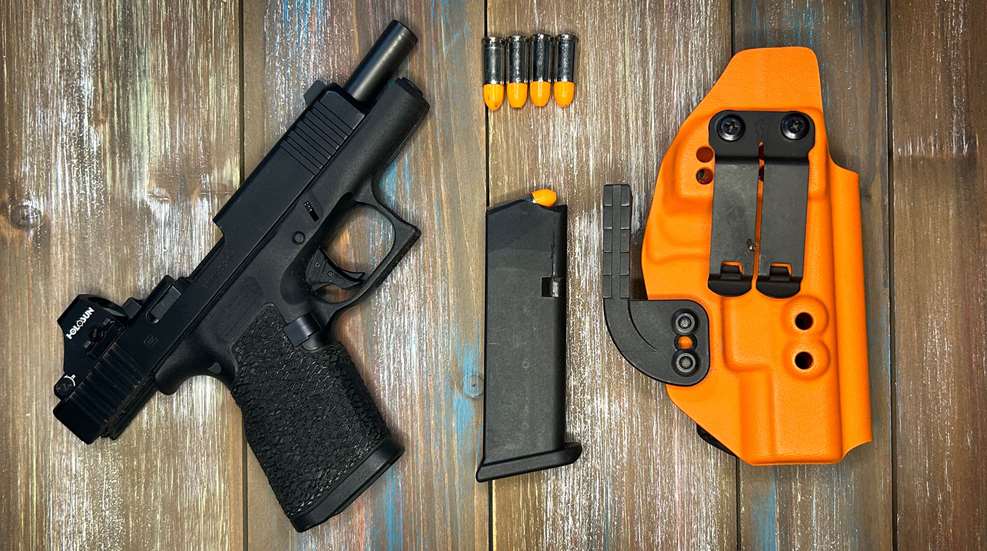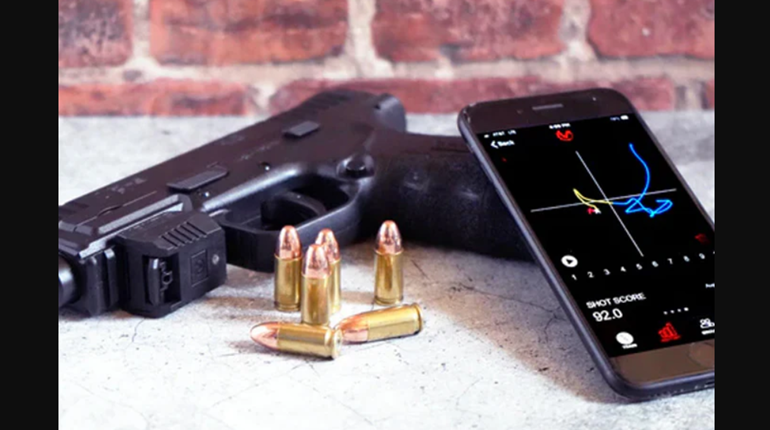
I teach and attend many handgun classes every year, and the most common struggle I observe is, surprisingly, not pistol marksmanship. Instead many handgun owners, whether novices or longtime shooters, struggle with competent and comfortable gun handling. In some cases the shooters are unpracticed and uncomfortable in handling their firearms. In other cases, more experienced shooters have gotten by with suboptimal habits that have never been corrected, and struggle to adjust and observe the best practices in gun handling. Safe, competent, confident gun handling is the highest priority and first step to becoming an armed citizen, and dry practice is the best avenue to learn it. Let’s examine how to set ourselves up for success with quality, thoughtful, deliberate dry-practice sessions that will lead to competence and confidence in handling our handguns.
Gun Handling Defined
Gun handling, on or off the range, includes far more than just pointing your handgun at the target, confirming the sights are aligned on target and pressing the trigger. For simplicity’s sake we’ll discuss the most popular form of handgun today, the semi-automatic pistol. Gun handling, as the name implies, includes everything you need to be able to do from the moment you pick up your handgun all the way up until the point you return it to its resting place. This means habitually keeping the muzzle of your handgun oriented in the safest direction possible. It also means habitually keeping your finger straight and well off the trigger until you’ve made the decision to shoot and your muzzle is on the target. We must also be able to lock the slide to the rear so that we can ensure the pistol is clear of ammunition when necessary, as well as reload the handgun, all without violating the safety rules about muzzle direction and keeping our finger off the trigger. If working from a holster, we must also be able to draw and holster the handgun while keeping our finger straight and well off the trigger and keep the muzzle away anyone who is in our immediate vicinity, as well as ourselves. Fortunately, all of this can be practiced with dry-practice done safely in our homes, which will greatly increase our safety, efficiency and enjoyment during our live-fire practice sessions or attendance at formal classes.
Safety First, Last, and Always
To safely dry practice at home with a handgun, it's important to take several precautions. First, familiarize yourself with how your particular handgun operates by reading the owner's manual and watching videos from reputable sources like the manufacturer or the NRA. Next, find a dedicated location for dry practice that offers privacy and a good backstop. Practicing in a private area not only allows for focus, but also prevents the risk of inadvertently pointing the gun at family members or pets. A suitable backstop is crucial in case of a negligent discharge (which we will discuss avoiding below). It's ideal to practice in a basement facing an exterior wall or an exterior wall that doesn't face a neighbor's home. Targets (such as printable 1/3 size IPSC or IDPA targets) can be affixed to objects that are likely to stop or substantially slow a bullet in the event of a negligent discharge, such as a fully loaded deep freezer. I personally use an old set of body armor with rifle-rated plates as my backstop in my garage. If there's no suitable location within the home, consider finding another location like a friend's house, or incorporating dry-practice into the beginning of your range sessions.
Once we have a suitable location, the next step is to ensure we have no live ammunition present for our dry-practice session. That means ensuring there is zero live ammunition in the same room where you will dry practice. This may seem excessive, but the risk of grabbing the wrong magazine off the shelf or table and it containing live rounds is unacceptable. Dummy rounds can be useful for practicing loading and reloads, but ensure they are dramatically different in appearance from your live ammunition and inspect every dummy round prior to beginning dry practice.
Once we have taken our handgun into the dry-practice space, along with magazines, holster, dummy rounds, and any other training aids, we must ensure the gun is clear. Remove the gun from the case or holster, remove the magazine if one is present by pressing the magazine release button or lever, and lock the slide to the rear by pressing the slide latch upward with continuous pressure from the firing hand thumb while pulling the slide to the rear with the non-firing hand. Many struggle with this step, as it requires grip strength and dexterity some lack, at least initially. If unable to do this, one solution is to insert an empty magazine (check first to ensure the magazine contains no rounds), and then pull the slide to the rear without bothering with the slide latch. The empty magazine will lock the slide to the rear, then drop the magazine and the slide will remain locked to the rear. Inspect the magazine well within the grip to ensure it is empty, inspect the chamber to make sure there is not a round present, and inspect the bolt-face and extractor and make sure there is no round present within the ejection port (which will be hard to miss). All of these steps must be completed while maintaining the finger straight and well away from the trigger, and with the muzzle oriented in the safest direction. If you cannot perform these steps without keeping your finger off the trigger and muzzle in a safe direction, you need to continue practicing the steps until you are able to consistently able to do so.
Clear, Load, Draw, Shoot, & Holster Safely
Once we have ensured the pistol is clear of all ammunition, we can begin our dry-practice session. It is advisable to replicate your real world use of the handgun in dry-practice as closely as possible. If you keep your handgun in a quick access safe for home defense, practice entering the combination and withdrawing the handgun. If you intend to carry your handgun outside the home in a holster, then dry practice that way. Practice clearing your cover garment, getting a good grip with your firing hand, and drawing the handgun. In both cases, move the muzzle to your target while being mindful of the safest path your handgun takes to get to the target, and keeping your finger straight and high along the slide until ready to press the trigger. Practice removing your finger from the trigger guard as you complete the process of dry-firing, every single time, before returning the handgun to the safe, table, or holster for the next repetition. Practice reloading by locking the slide to the rear on an empty magazine, pressing the magazine release, and then inserting a new magazine loaded with dummy rounds and releasing the slide forward whether with the slide latch or by racking the slide. Make sure that when clearing, loading, drawing, reloading, or holstering that you keep your finger straight and high along the slide, and ensure your muzzle is always pointed in the safest direction or taking the safest path possible to arrive there.
Final Thoughts
Practice these steps until you can perform them correctly and automatically, with little deliberate thought. Practice these steps until you are comfortable handling your gun with a focused but relaxed mindset that will allow you to get the most out of your live-fire practice and training. Your range sessions and formal class experiences will be much more enjoyable if you are competent and comfortable handling your firearm safely, and routine, thoughtful dry-practice will help you get there.






































